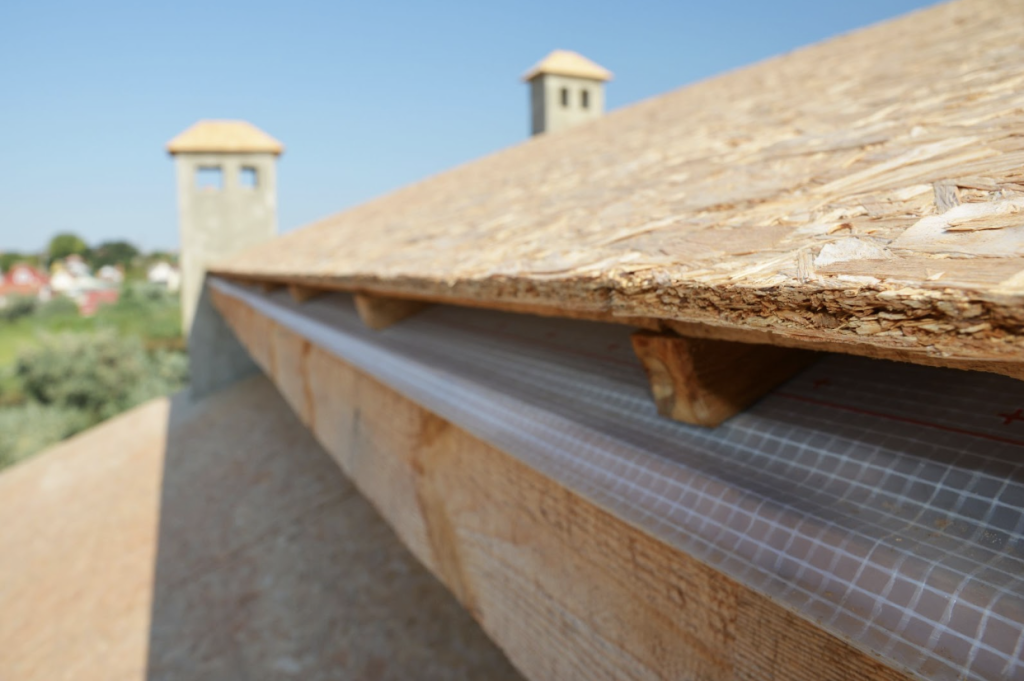A solid roof is more than just a protective covering; it’s the first line of defense against the elements and a key factor in your home’s overall stability. Yet, many are unaware of the vital role roof sheathing plays in this equation. Often hidden beneath the shingles, roof sheathing is the unsung hero. But what is roof sheathing exactly, and why does it matter?
In this article, we’ll peel back the layers to reveal the fascinating world of roof sheathing. From the different materials used in the installation process, you’ll gain a deeper understanding of how this essential component contributes to your home’s longevity and safety.
Join us as we explore the critical functions of the roof sheathing and discover why it deserves your attention!

What Is Roof Sheathing?
Roof sheathing, also known as decking, is a crucial component of your roof’s structure. It consists of a layer of material installed directly on top of the roof’s structural framework, which includes rafters or trusses.
This layer serves as a foundation for the outer roofing materials, such as shingles, tiles, or metal panels. Roof sheathing creates a uniform surface that helps distribute weight and stabilizes the roofing system.
The quality and condition of roof sheathing significantly impact your roof’s overall performance and longevity. Properly installed and maintained sheathing can protect your home from water damage, improve energy efficiency, and enhance the roof’s structural integrity.
What type of plywood is used for roof sheathing?
The most common materials used for roof sheathing are plywood and oriented strand board (OSB). Plywood offers excellent strength and durability, while OSB is generally more cost-effective and resistant to warping.
In some cases, particularly in older homes, wood planks may be used as roof sheathing. Each material has advantages in terms of cost, durability, and ease of installation.
The choice of sheathing material often depends on factors such as climate, budget, and local building codes. It’s important to consult with a roofing professional like us at Tallahassee Roofing to determine the best option for your specific needs.
Purpose of roof sheathing
The primary purpose of roof sheathing is to provide essential structural support to the roof. By creating a solid base, it can effectively withstand the weight of roofing materials and external forces, such as wind and snow.
In addition to its foundational role, roof sheathing is an anchor point for attaching various roofing materials. This feature ensures that the weight of these materials is distributed evenly across the roof structure, which helps prevent the formation of stress points.
Moreover, roof sheathing is crucial for maintaining your roof’s overall shape and integrity. It plays a vital role in resisting shear forces generated by wind and seismic activity, contributing significantly to your home’s stability. Overall, roof sheathing is critical for structural support and your roofing system’s long-term durability and resilience.
Roof sheathing and insulation
We must emphasize that proper roof sheathing is crucial for your home’s insulation and energy efficiency. It serves as a protective barrier against external elements, ensuring a consistent indoor temperature. High-quality roof sheathing not only contributes to a more comfortable living environment but also helps reduce energy bills.
This benefit is particularly pronounced when roof sheathing is paired with adequate ventilation and insulation in the attic. Certain types of roof sheathing, such as insulated panels, add extra R-value to your roofing system. This improved insulation might enhance your home’s energy performance, minimizing heat loss during winter and reducing heat gain in summer.
Signs of damaged roof sheathing
A sagging roof is one of the most evident signs of damaged roof sheathing. If you notice dips or waves in the roofline, this may suggest that the sheathing has weakened or rotted.
Besides, water stains on your ceiling or attic and soft spots when walking on the roof further indicate potential sheathing damage. It is crucial to address these issues promptly to prevent further structural damage to your home.
Other signs of compromised roof sheathing include visible daylight streaming through the roof boards in your attic. You may also experience a spongy sensation when walking on the roof or find excessive moisture in the attic space. Our regular roof inspections can help catch these problems early, preventing them from escalating into more extensive damage.

Conclusion
So, what is roof sheathing? It is a vital yet often overlooked component of your home’s roofing system. As a foundation for outer roofing materials, it contributes to structural stability, energy efficiency, and protection against the elements.
Understanding the materials used, such as plywood and oriented strand board, and recognizing the signs of damage are crucial for maintaining the integrity of your roof. Regular inspections and proper roof sheathing installation enhance your home’s durability and ensure a comfortable living environment.
If you need expert guidance and reliable solutions, Tallahassee Roofing offers unparalleled expertise in roof sheathing and overall roofing needs. With a commitment to quality craftsmanship and customer satisfaction, we have built a reputation for reliability and professionalism in every project.
Contact us today for a consultation and let our experts help you protect your home with quality roof sheathing and roofing solutions!
